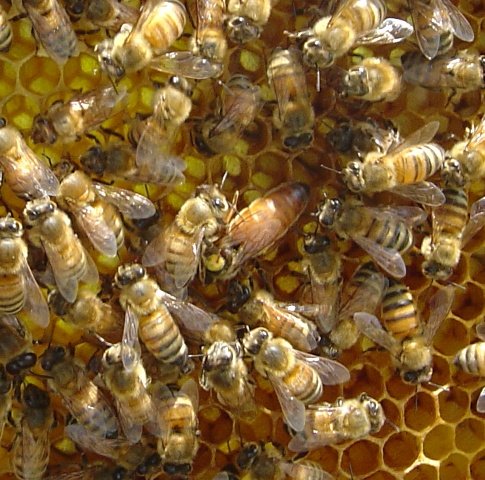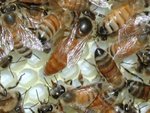Well it is the end of October. We have been preparing our hives for winter since the honey crop was removed on September first. I have come to learn that next years beekeeping begins now in the fall. In order to have strong hives next spring the colonies need to be properly prepared in the fall. I will say it again… The success of next years beekeeping depends on what we do now.
.
.
.
.
.
.
.
.
Above: A hive top feed being installed on a colony. You can see that a pollen substitute patty, and a Crisco and sugar patty has been installed in the hive. The pollen patty ensures nutrition. The Crisco and sugar patty treats varroa and trachea mites.
Some people are beehavers. They have bees, there bees die, they get more bees, they have them, those bees die.
Some people are beekeepers. They keep there bees healthy year after year..
.
.
.
.
.
.
.
Above: 2:1 sugar syrup being poured into the hive top feeder. The bees will collect this sugar syrup and store it for food to be consumed this winter.
I have been amazed that our mite problem still exists in the previously treated hives. Once high levels of varroa mite levels are detected, treatment of the hives began immediately. It takes 3 weeks to treat with formic acid pads, and with the weather getting cooler the formic acid vapors will not be as effective as they were in early September.
.
.
.
.
.
.
.
.
Above: Robbing was so bad this year that I had to install weather stripping between the feeders and the cover to prevent bees from stealing the sugar syrup.
Our winter preparations in October and the first two weeks of November include the following.
1: Colonies are inspected for health. Is the colony strong? Is the colony health? Is there an adequate number of bees to insure the colonies survival through the winter months. Have the bees produced enough comb to store food. Sometimes the combs of bees need to be rearranged so that all the drawn comb and honey stores are located in the upper brood chamber. Empty frames and un-drawn frames of foundation are moved to the lower brood chamber. Since the bees will over-winter in the top box, this should be the location of most of their stores.
2: The hives are inspected for adequate winter stores of pollen and honey. If there is less than 50 lbs of honey in the colony the hives will be fed with a 2:1 ration of sugar syrup. Two parts sugar to one part water. All our colonies are fed sugar syrup and pollen substitute to insure they have more than enough supplies for winter.
Robbing has been a big problem this year. One drop of syrup outside the hive causes thousands of bees to go searching for the syrup. Once this starts hives will attempt to rob other hives of their winter stores. The battle is amazing to watch, but it is not good for the bees. Because of this problem we have installed entrance reducers on all the hives to help them protected themselves against robbing.
3: Mouse guards and entrance reducers are installed on all the hives to keep mice from building nests in the dry cozy hives..
.
.
.
.
.
.
.
Above: Formic acid pads installed over a colony in order to reduce the varroa mites.
4: All colonies are evaluated for varroa mites. If varroa mites are found in large numbers the colonies are treated for varroa and trachea mites using formic acid applications.
5: Ventilation will be provided above the colonies to allow moisture out of the hive. By placing two square toothpicks under the back side of the inner cover, a ventilation space is created. This ventilation will keep moisture from building up on the underside of the cover which would drip on the colony. The cold will not harm a healthy cluster of bees, but cold damp conditions will. I also install a layer of newspaper above the ventilation space. This newspaper will absorb any moisture that may collect, keeping it from effecting the colony..
.
.
.
.
.
.
.
.
Above: Entrance reducers and mouse guards are installed on the hives to prevent the entrance of mice. The mice love to spend the winter in the dry hives. Once inside the mice will destroy the comb to make room for it's nest. You can see the bees bringing in the fall pollen.
6: Review this past seasons beekeeping notes. Identify what went wrong and why. Correct these deficiencies.
Learn by your mistakes!
October 30, 2007
Winterize
Subscribe to:
Post Comments (Atom)
Spring

Peach Pollen
Spring Pollen

Queen Cell

Well Fed Queen Cell
Marked Queen

Queen produced from my second graft attempt









No comments:
Post a Comment